1) Nogodan’s clouded sea
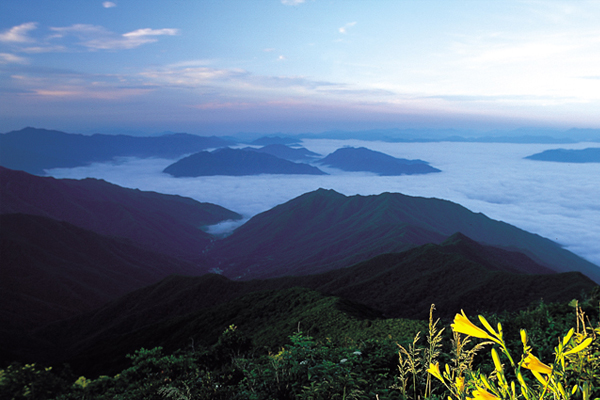
Standing at a height of 1,507 meters above sea level, Nogodan, along with Cheonwangbong and Banyabong, is one of the three major peaks of Jirisan Mountain and is considered the most sacred peak among others. In particular, the view of the clouded sea extending beneath Nogodan is the greatest scenic beauty of the country that made Jirisan Mountain the most famous one among others. From the south, when clouds and fog surf like waves and surrounds Nogodan, Mt. Jiri forms a magnificent view of the beautiful sea of clouds.
2) The setting sun of the Banyabong

Banyabong, the second-highest peak on Jirisan Mountain at 1,732 meters above sea level, is located in the heart of the Jirisan Mountain area, a 5.5-kilometer point northeast leading to a high ridge stretching from Nogodan to Imgulryung, which allows us to see the panoramic view of Jirisan Mountain. The reward for the hard work of climbing the Banyabong is to appreciate the spectacular glow of the setting sun. Watching the sun, which had heated the ground during the day, disappears over the mountain, gradually giving way to the darkness, it seems human worldly desires and evil feelings, too, seem to be fading away.
3) Piagol Autumn Foliage
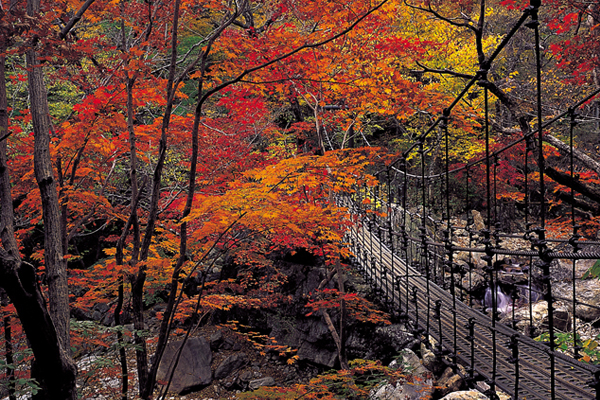
4km further past the Yongok temple you will reach a dense forest. This is piagol, the largest deciduous forest zone of Jirisan Mountain, where you can enjoy the scenery all year round. The combination of colorful colors of leaves that culminate in late October, as if elaborately drawn by an artist, captivates our minds. The name 'Three Reds' is a metaphorical expression that mountains turn red, water turns red, and people turn red. The autumn foliage of Piagol is the best view of Jirisan Mountain.
4) Clear Waters of the Seomjingang River

Seomjingang River is a 200km long river that originates from Maisan Mountain, Jinan-gun, and flows through 12 city basins of Jeollabuk-do, Jeollanam-do, and Gyeongsangnam-do, and is known as the cleanest river in the country. The river meandered through the mountains between Jirisan Mountain and Baegunsan Mountain, creating a half-moon-shaped white sand beach. The river is home to about 30 species of freshwater fish, including sweet fish, mullet, carp, eel and blue crab, and salmon have been returning during their spawning season as young salmon have been released in every March since 1998.
5) Sandong Cornelian Cherry Blossom

Spring in Korea begins as the cornus flowers bloom in Sandong, Gurye-gun. This flower blooms until the beginning of April after the flower bud bursts in late February. In November, it bears the lustful rubi light fruit. Sandong, Gurye-gun, is the country's largest producer of cornus and accounts for more than 70% of the country's production. It is said that the name of Sandong came from the story that says a maiden from Sandong province of China married a man living in Jirisan Mountain and she brought a cornus tree with her and planted it.
6) Seomjingang River Cherry Blossom Road
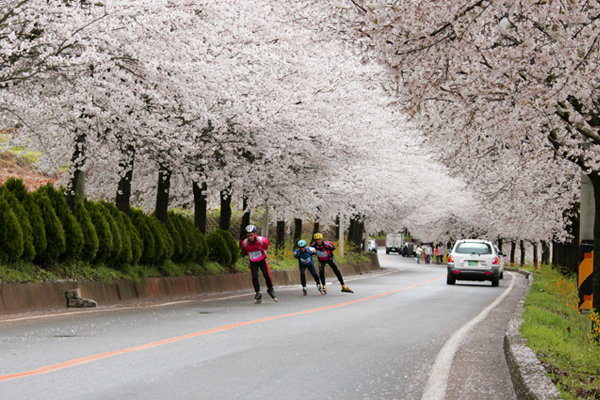
By the time the yellow cornus flowers wither in early spring, the white cherry blossoms bloom as if they dress the crystal clear Seomjingang River. By this time, the cherry blossom festival along Seomjingang River is held here. White cherry blossoms are blooming along the riverside along National Route 17 and 19 that connect Gokseong-gun to Hadong-gun, which have been built since 1992. You can for a ride while enjoying the beauty of spring the road gives you, which is also gaining popularity as the best marathon course.
7) Surakpokpo Falls
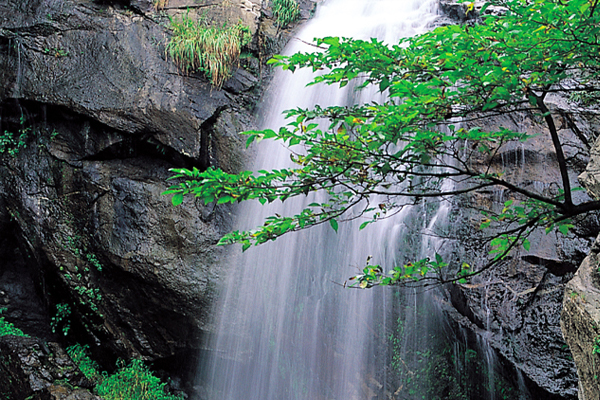
Surakpokpo Fallss is located in Sugiri, 4 km from Wonchon Village in Sandong-myeon and its water provides a beautiful view as if silver powder is pouring from the sky. In summer, many women are cooling off with water landing on their bodies that falls from the 15-meter high waterfall. This is known to be effective for neuralgia, muscle aches and postpartum pain, and an increasing number of people are visiting the area. It is also known that Song, man-gap, the master of pansori, practiced vocal exercises here to reach the highest level in Korean traditional music.
8) Hwaeomsa Temple, the Korea's finest antiquity
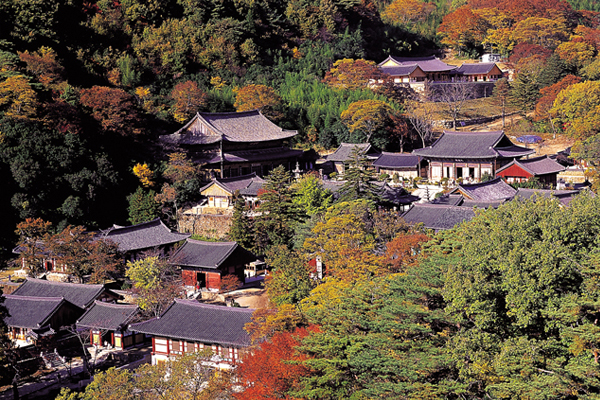
It is the largest and most majestic temple in Jirisan Mountain. It was built in 544 (the 22nd year of King Sunjong, Baekje), and was named after the Buddhist scripture, Hwaeom.
Recently, bones of the Budha' were found in Five-story Stone Pagoda. Plus, in the temple, there are many cultural assets, including four national treasures, eight treasures, one historic site, one scenic spot, two natural monuments, and two local cultural properties. Jirisan Mountain has long been considered a cradle of Buddhist culture in which there are many historic temples including Hwaeomsa Temple, Cheoneunsa Temple and Yeongoksa Temple. It is filled with many beautiful natural sceneries and Buddhist cultures including 'Nogodan' and Haweomsa Brook.
9) Osan Mountain and Saseongam Temple

Osan Mountain is a 531m-high mountain located in Jukmari, Muncheok-myeon. The mountain is not steep but offers many scenic views, so it is popular for family hiking and picnics courses. Saseongam Temple is said to have been built by Yeonkijosa in 544 (22 years of of King Sungjong, Baekje). On the rock wall is a sculpture of a standing Buddha, which is called a Maeyuraipsang. Initially, it was called Osanam and it was later called Saseongam (Rocks of four saints) in honor of the four Buddhist saints, Wonhyo, Dosun, Jingak, Uesan who practiced spiritual exercise here.
10) Nogodan snow scene

The summit of Nogodan, also called gilsangbong, has a gentle slope from the summit to the west, with a wide plateau of 1,000,000㎡. In ancient times, it was said that there was a Namaksa Temple where they worship Sundosungmo, the guardian spirit of the Jirisan Mountain. At this time, it got the name 'Dan,' which stems from the word altar where the ancestral rites are held to the Old Female Guardian of the Mountain. Also, nogodan is the starting point of the west when crossing Jirisan Mountain, and hiking trails such as Hwaeomsa Temple, Cheoneunsa Temple, Manbokdae, Piagol, and Bamsagol pass through it. In addition, the Nogodan shows us the seasonal beauty, such as azaleas in spring, daylily and clouded sea in summer, foliage in autumn, and snow covered field and mountains in winter.
